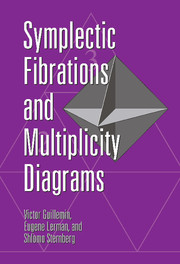Book contents
- Frontmatter
- Contents
- Acknowledgments
- Introduction
- 1 Symplectic Fibrations
- 2 Examples of Symplectic Fibrations: The Coadjoint Orbit Hierarchy
- 3 Duistermaat–Heckman Polynomials
- 4 Symplectic Fibrations and Multiplicity Diagrams
- 5 Computations with Orbits
- Appendix A Multiplicity Formulas
- Appendix B Equivariant Cohomology
- Appendix C Update
- Bibliography
- Index
2 - Examples of Symplectic Fibrations: The Coadjoint Orbit Hierarchy
Published online by Cambridge University Press: 03 February 2010
- Frontmatter
- Contents
- Acknowledgments
- Introduction
- 1 Symplectic Fibrations
- 2 Examples of Symplectic Fibrations: The Coadjoint Orbit Hierarchy
- 3 Duistermaat–Heckman Polynomials
- 4 Symplectic Fibrations and Multiplicity Diagrams
- 5 Computations with Orbits
- Appendix A Multiplicity Formulas
- Appendix B Equivariant Cohomology
- Appendix C Update
- Bibliography
- Index
Summary
As we pointed out in the introduction the purpose of this monograph is to explore connections between two subjects which seem to have, on the face of it, little to do with each other: symplectic fibrations and the multiplicity diagrams associated with representations of Lie groups. What will supply the bridge between these two topics is the coadjoint orbit hierarchy. There are several ways of describing this hierarchy, but the one we will give here is probably the simplest: A coadjoint orbit O1 will sit higher in this hierarchy than O2 if there exists an equivariant symplectic fibration of O1 over O2. Thus, at the bottom of the hierarchy will sit the coadjoint orbits that can't be fibered over lower-dimensional coadjoint orbits. For example, for SU(n) these are the complex Grassmannians and for SO(2n) they include the complex quadrics and the “isotropic” Grassmannian. These minimal orbits correspond in representation theory to the fundamental representations of the groups SU(n) and SO(In) and will play the same role here as their representationtheoretic counterparts.
To get a feeling for this hierarchy, it will be helpful to take a look at other examples of symplectic fibrations as well, and, in fact, without wandering too far from the goal we have in mind – the attempt to explain “lacunae” in multiplicity diagrams – we will discuss quite a few examples of symplectic fibrations that have little to do with coadjoint orbits and representation theory. (These include, in particular, two examples about which quite a bit is being written at the moment: Riemannian fibrations with totally geodesic fibers and symplectic fibrations with the Hannay–Berry connection.
- Type
- Chapter
- Information
- Symplectic Fibrations and Multiplicity Diagrams , pp. 21 - 53Publisher: Cambridge University PressPrint publication year: 1996

